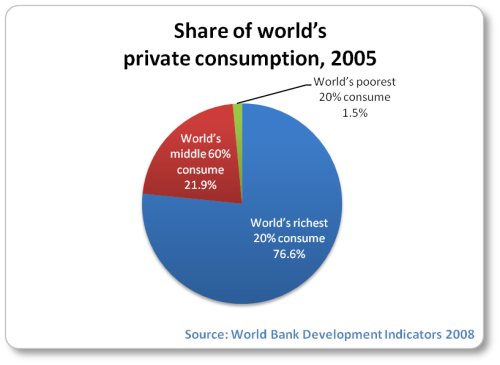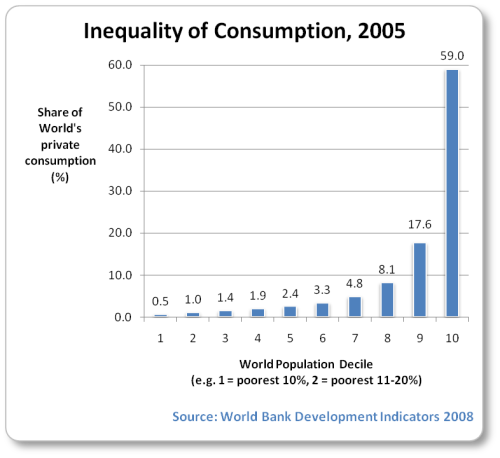Consumption and Consumerism
by Anup Shah
Global inequality in consumption, while reducing, is still high. Using latest figures available, in 2005, the wealthiest 20% of the world accounted for 76.6% of total private consumption. The poorest fifth just 1.5%:

Breaking that down slightly further, the poorest 10% accounted for just 0.5% and the wealthiest 10% accounted for 59% of all the consumption:

In 1995, the inequality in consumption was wider, but the United Nations also provided some eye-opening statistics (which do not appear available, yet, for the later years) worth noting here:
"Today’s consumption is undermining the environmental resource base. It is exacerbating inequalities. And the dynamics of the consumption-poverty-inequality-environment nexus are accelerating. If the trends continue without change — not redistributing from high-income to low-income consumers, not shifting from polluting to cleaner goods and production technologies, not promoting goods that empower poor producers, not shifting priority from consumption for conspicuous display to meeting basic needs — today’s problems of consumption and human development will worsen.
…The real issue is not consumption itself but its patterns and effects.
…Inequalities in consumption are stark. Globally, the 20% of the world’s people in the highest-income countries account for 86% of total private consumption expenditures — the poorest 20% a minuscule 1.3%. More specifically, the richest fifth:
• Consume 45% of all meat and fish, the poorest fifth 5%
• Consume 58% of total energy, the poorest fifth less than 4%
• Have 74% of all telephone lines, the poorest fifth 1.5%
• Consume 84% of all paper, the poorest fifth 1.1%
• Own 87% of the world’s vehicle fleet, the poorest fifth less than 1%
Runaway growth in consumption in the past 50 years is putting strains on the environment never before seen."
source: Human Development Report 1998 Overview
(United Nations Development Programme (UNDP) — Emphasis Added. Figures quoted use data from 1995)
If more recent statistics [ed] were available, it would likely be that the breakdowns shown for the 1995 figures will not be as wide in 2005. However, they are likely to still show wide inequalities in consumption. Furthermore, as a few developing countries continue to develop and help make the numbers show a narrowing gap, there are at least two further issues:
• Generalized figures hide extreme poverty and inequality of consumption on the whole (for example, between 1995 and 2005, the inequality in consumption for the poorest fifth of humanity has hardly changed)
• If emerging nations follow the same path as today’s rich countries, their consumption patterns will also be damaging to the environment
And consider the following, reflecting world priorities:
| Global Priority | $U.S. Billions |
|---|---|
| Cosmetics in the United States | 8 |
| Ice cream in Europe | 11 |
| Perfumes in Europe and the United States | 12 |
| Pet foods in Europe and the United States | 17 |
| Business entertainment in Japan | 35 |
| Cigarettes in Europe | 50 |
| Alcoholic drinks in Europe | 105 |
| Narcotics drugs in the world | 400 |
| Military spending in the world | 780 |
And compare that to what was estimated as additional costs to achieve universal access to basic social services in all developing countries:
| Global Priority | $U.S. Billions |
|---|---|
| Basic education for all | 6 |
| Water and sanitation for all | 9 |
| Reproductive health for all women | 12 |
| Basic health and nutrition | 13 |
source: The State Of Human Development (United Nations Human Development Report 1998, Chapter 1, p.37)
We consume a variety of resources and products today having moved beyond basic needs to include luxury items and technological innovations to try to improve efficiency. Such consumption beyond minimal and basic needs is not necessarily a bad thing in and of itself, as throughout history we have always sought to find ways to make our lives a bit easier to live. However, increasingly, there are important issues around consumerism that need to be understood. For example:
• How are the products and resources we consume actually produced?
• What are the impacts of that process of production on the environment, society, on individuals?
• What are the impacts of certain forms of consumption on the environment, on society, on individuals?
• Which actors influence our choices of consumption?
• Which actors influence how and why things are produced or not?
• What is a necessity and what is a luxury?
• How do demands on items affect the requirements placed upon the environment?
• How do consumption habits change as societies change?
• Businesses and advertising are major engines in promoting the consumption of products so that they may survive. How much of what we consume is influenced by their needs versus our needs?
• Also influential is the very culture of today in many countries, as well as the media and the political institutions themselves. What is the impact on poorer nations and people on the demands of the wealthier nations and people that are able to afford to consume more?
• How do material values influence our relationships with other people?
• What impact does that have on our personal values?
• And so on...
Just from these questions, we can likely think of numerous others as well. We can additionally, see that consumerism and consumption are at the core of many, if not most societies. The impacts of consumerism, positive and negative are very significant to all aspects of our lives, as well as our planet. But equally important to bear in mind in discussing consumption patterns is the underlying system that promotes certain types of consumption and not other types.
Inherent in today’s global economic system is the wasteful use of resources, labor and capital. These need to be addressed. Waste is not only things like via not recycling etc; it is deep within the system.
The U.N. statistics above are hard hitting, highlight one of the major impacts of today’s form of corporate-led globalization.
“Over” population is usually blamed as the major cause of environmental degradation, but the above statistics strongly suggests otherwise. As we will see, consumption patterns today are not to meet everyone’s needs. The system that drives these consumption patterns also contributes to inequality of consumption patterns too.
Entire volumes of research can be written on this topic; globalissues.org provides an introductary look at various aspects of what we consume and how.